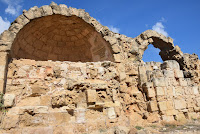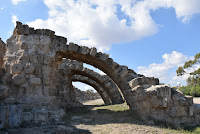As we drove onto the former Roman Salamis, which would later become Byzantine Constantia, the island's main port and capital for a thousand years I sighted the Royal necropolis by the side of the road and managed to take a photo from inside the bus.
Royal tomb from the 7th a nd 8th centuries BC, west of Salamis.
Upon reaching what is considered by many as the most interesting archaeological excavation site on Cyprus we headed towards the Roman Theatre which was built 2,000 years ago during the reign of Emperor Augustus and could hold up to 15,000 spectators.



We continued onto the rather impressive Gymnasium via the Amphitheatre and the stone cisterns and other remains of an aqueduct that used to supply the baths and the pools with water.




From it we walked into a semi-circular colonnaded structure containing a latrine which could be used by 44 people simultaneously.

We then explored the Sudatorium and the Caldarium, pertaining to the Greek-Roman baths complex system with steam bath pools and hot bath chambers both of which fitted with underfloor heating systems. Some well preserved frescoe paintings and mosaics could still be seen as we strolled along the huge ensemble admiring the structure and looking at unique details.







































No comments:
Post a Comment